2014 BMW 435I COUPE tire pressure
[x] Cancel search: tire pressurePage 170 of 236

Saving fuelVehicle equipmentAll standard, country-specific and optional
equipment that is offered in the model series is
described in this chapter. Therefore, equip‐
ment is also described that is not available in a
vehicle, e. g., because of the selected optional
equipment or country variant. This also applies
for safety-related functions and systems.
General information Your vehicle contains advanced technology for
the reduction of fuel consumption and emis‐
sions.
Fuel consumption depends on a number of dif‐
ferent factors.
The implementation of certain measures, driv‐
ing style and regular maintenance can have an
influence on fuel consumption and on the envi‐
ronmental impact.
Remove unnecessary cargoAdditional weight increases fuel consumption.
Remove attached parts
following use
Remove auxiliary mirrors, roof or rear luggage
racks which are no longer required following
use.
Attached parts on the vehicle impair the aero‐
dynamics and increase the fuel consumption.Close the windows and glass
sunroof
Driving with the glass sunroof and windows
open results in increased air resistance and
raises fuel consumption.
Tires General information
Tires can affect fuel consumption values in
various ways, for instance fuel consumption
can be influenced by the size of the tires.
Check the tire inflation pressure
regularly
Check and, if necessary, correct the tire infla‐
tion pressure at least twice a month and before
starting on a long trip.
Low tire inflation pressure increases rolling re‐
sistance and thus raises fuel consumption and
tire wear.
Drive away without delay Do not wait for the engine to warm-up while
the vehicle remains stationary. Start driving
right away, but at moderate engine speeds.
This is the fastest way for the cold engine to
reach its operating temperature.
Look well ahead when
driving
Avoid unnecessary acceleration and braking.
By maintaining a suitable distance to the vehi‐
cle driving ahead of you.
Driving smoothly and looking ahead reduces
fuel consumption.Seite 170Driving tipsSaving fuel170
Online Edition for Part no. 0140 2 909 827 - VI/13
Page 181 of 236
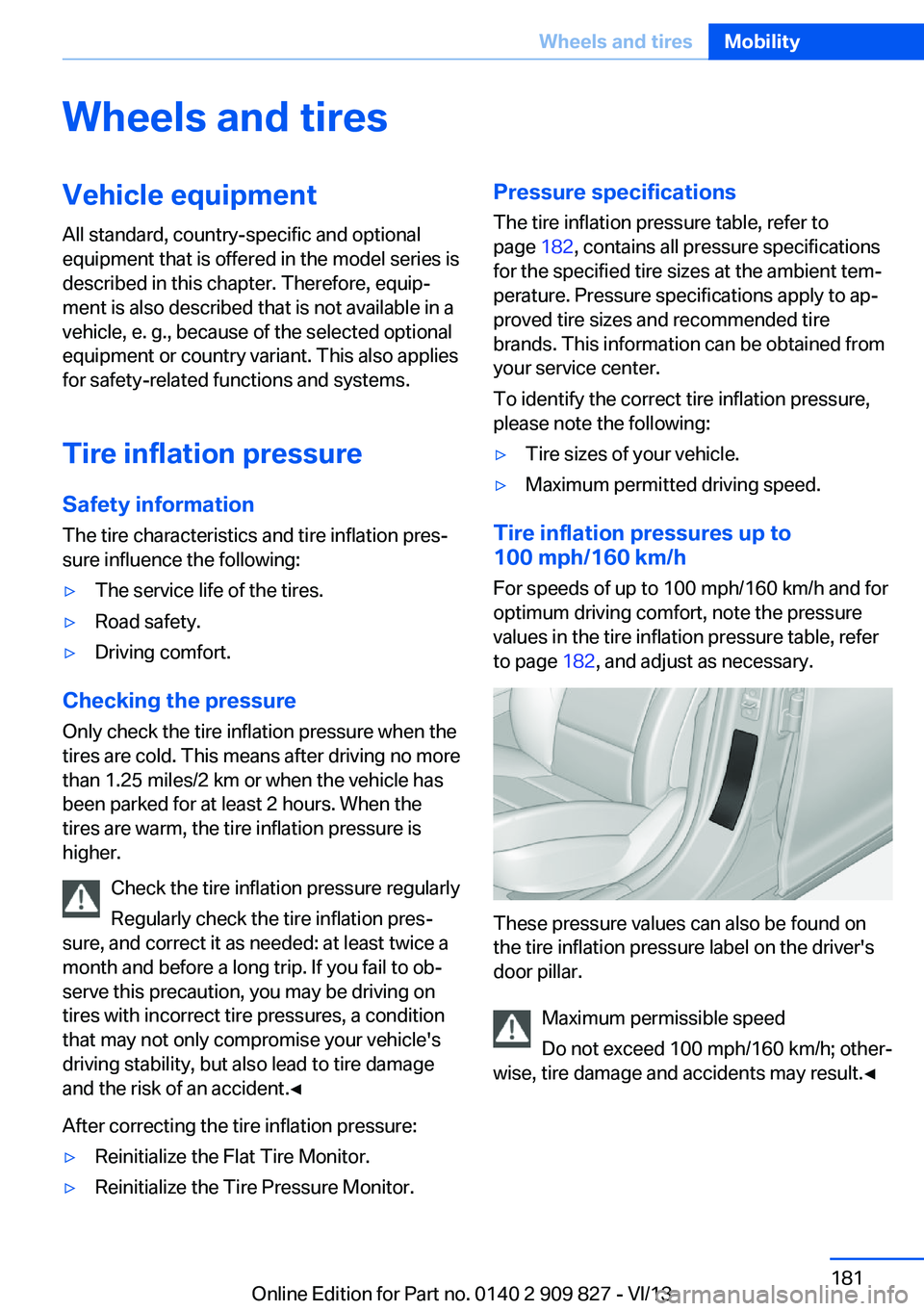
Wheels and tiresVehicle equipment
All standard, country-specific and optional
equipment that is offered in the model series is
described in this chapter. Therefore, equip‐
ment is also described that is not available in a
vehicle, e. g., because of the selected optional
equipment or country variant. This also applies
for safety-related functions and systems.
Tire inflation pressure Safety information
The tire characteristics and tire inflation pres‐
sure influence the following:▷The service life of the tires.▷Road safety.▷Driving comfort.
Checking the pressure
Only check the tire inflation pressure when the
tires are cold. This means after driving no more
than 1.25 miles/2 km or when the vehicle has
been parked for at least 2 hours. When the
tires are warm, the tire inflation pressure is
higher.
Check the tire inflation pressure regularly
Regularly check the tire inflation pres‐
sure, and correct it as needed: at least twice a
month and before a long trip. If you fail to ob‐
serve this precaution, you may be driving on
tires with incorrect tire pressures, a condition
that may not only compromise your vehicle's
driving stability, but also lead to tire damage
and the risk of an accident.◀
After correcting the tire inflation pressure:
▷Reinitialize the Flat Tire Monitor.▷Reinitialize the Tire Pressure Monitor.Pressure specifications The tire inflation pressure table, refer to
page 182, contains all pressure specifications
for the specified tire sizes at the ambient tem‐
perature. Pressure specifications apply to ap‐
proved tire sizes and recommended tire
brands. This information can be obtained from
your service center.
To identify the correct tire inflation pressure,
please note the following:▷Tire sizes of your vehicle.▷Maximum permitted driving speed.
Tire inflation pressures up to
100 mph/160 km/h
For speeds of up to 100 mph/160 km/h and for
optimum driving comfort, note the pressure
values in the tire inflation pressure table, refer
to page 182, and adjust as necessary.
These pressure values can also be found on
the tire inflation pressure label on the driver's
door pillar.
Maximum permissible speed
Do not exceed 100 mph/160 km/h; other‐
wise, tire damage and accidents may result.◀
Seite 181Wheels and tiresMobility181
Online Edition for Part no. 0140 2 909 827 - VI/13
Page 182 of 236
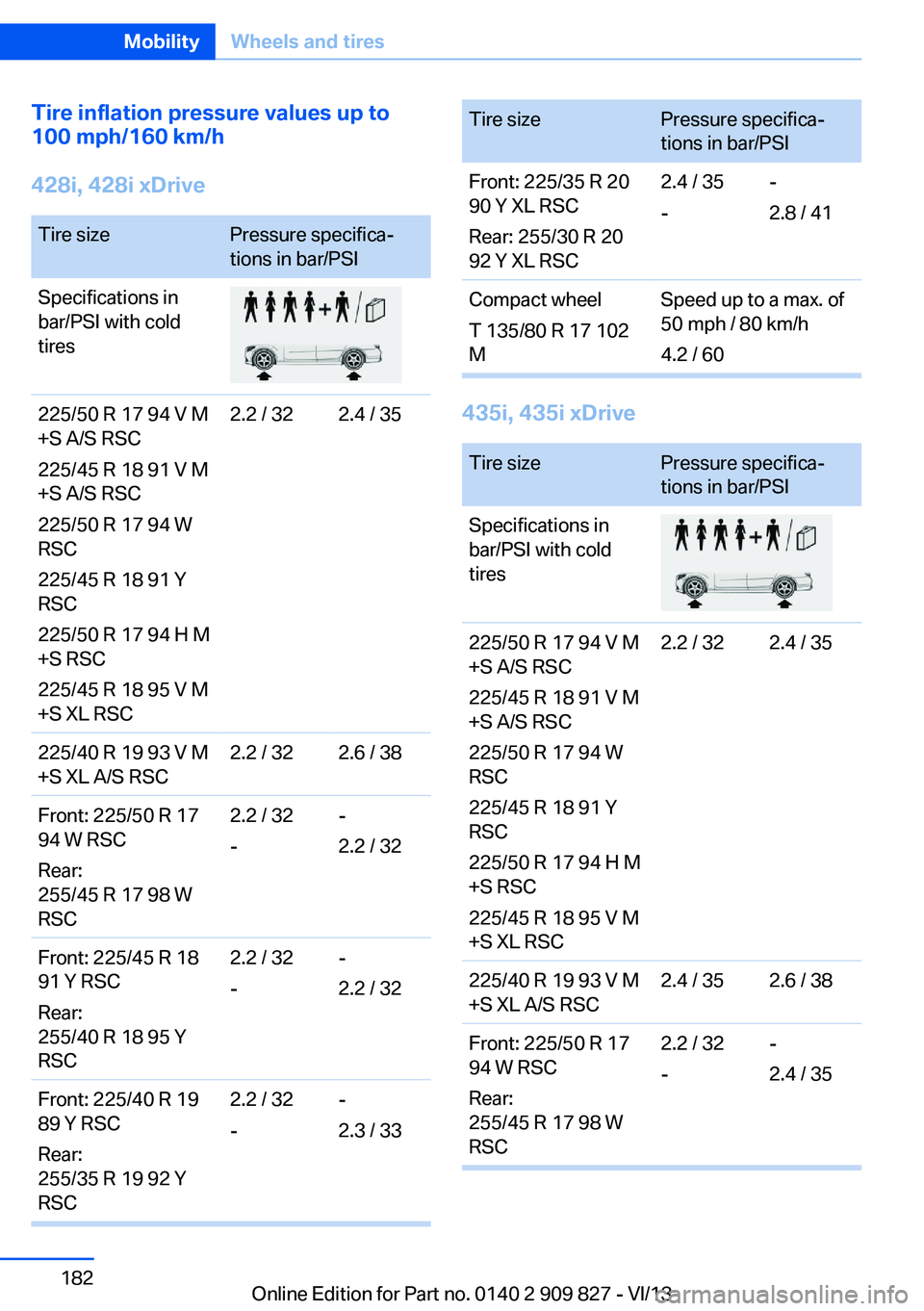
Tire inflation pressure values up to
100 mph/160 km/h
428i, 428i xDriveTire sizePressure specifica‐
tions in bar/PSISpecifications in
bar/PSI with cold
tires225/50 R 17 94 V M
+S A/S RSC
225/45 R 18 91 V M
+S A/S RSC
225/50 R 17 94 W
RSC
225/45 R 18 91 Y
RSC
225/50 R 17 94 H M
+S RSC
225/45 R 18 95 V M
+S XL RSC2.2 / 322.4 / 35225/40 R 19 93 V M
+S XL A/S RSC2.2 / 322.6 / 38Front: 225/50 R 17
94 W RSC
Rear:
255/45 R 17 98 W
RSC2.2 / 32
--
2.2 / 32Front: 225/45 R 18
91 Y RSC
Rear:
255/40 R 18 95 Y
RSC2.2 / 32
--
2.2 / 32Front: 225/40 R 19
89 Y RSC
Rear:
255/35 R 19 92 Y
RSC2.2 / 32
--
2.3 / 33Tire sizePressure specifica‐
tions in bar/PSIFront: 225/35 R 20
90 Y XL RSC
Rear: 255/30 R 20
92 Y XL RSC2.4 / 35
--
2.8 / 41Compact wheel
T 135/80 R 17 102
MSpeed up to a max. of
50 mph / 80 km/h
4.2 / 60
435i, 435i xDrive
Tire sizePressure specifica‐
tions in bar/PSISpecifications in
bar/PSI with cold
tires225/50 R 17 94 V M
+S A/S RSC
225/45 R 18 91 V M
+S A/S RSC
225/50 R 17 94 W
RSC
225/45 R 18 91 Y
RSC
225/50 R 17 94 H M
+S RSC
225/45 R 18 95 V M
+S XL RSC2.2 / 322.4 / 35225/40 R 19 93 V M
+S XL A/S RSC2.4 / 352.6 / 38Front: 225/50 R 17
94 W RSC
Rear:
255/45 R 17 98 W
RSC2.2 / 32
--
2.4 / 35Seite 182MobilityWheels and tires182
Online Edition for Part no. 0140 2 909 827 - VI/13
Page 183 of 236
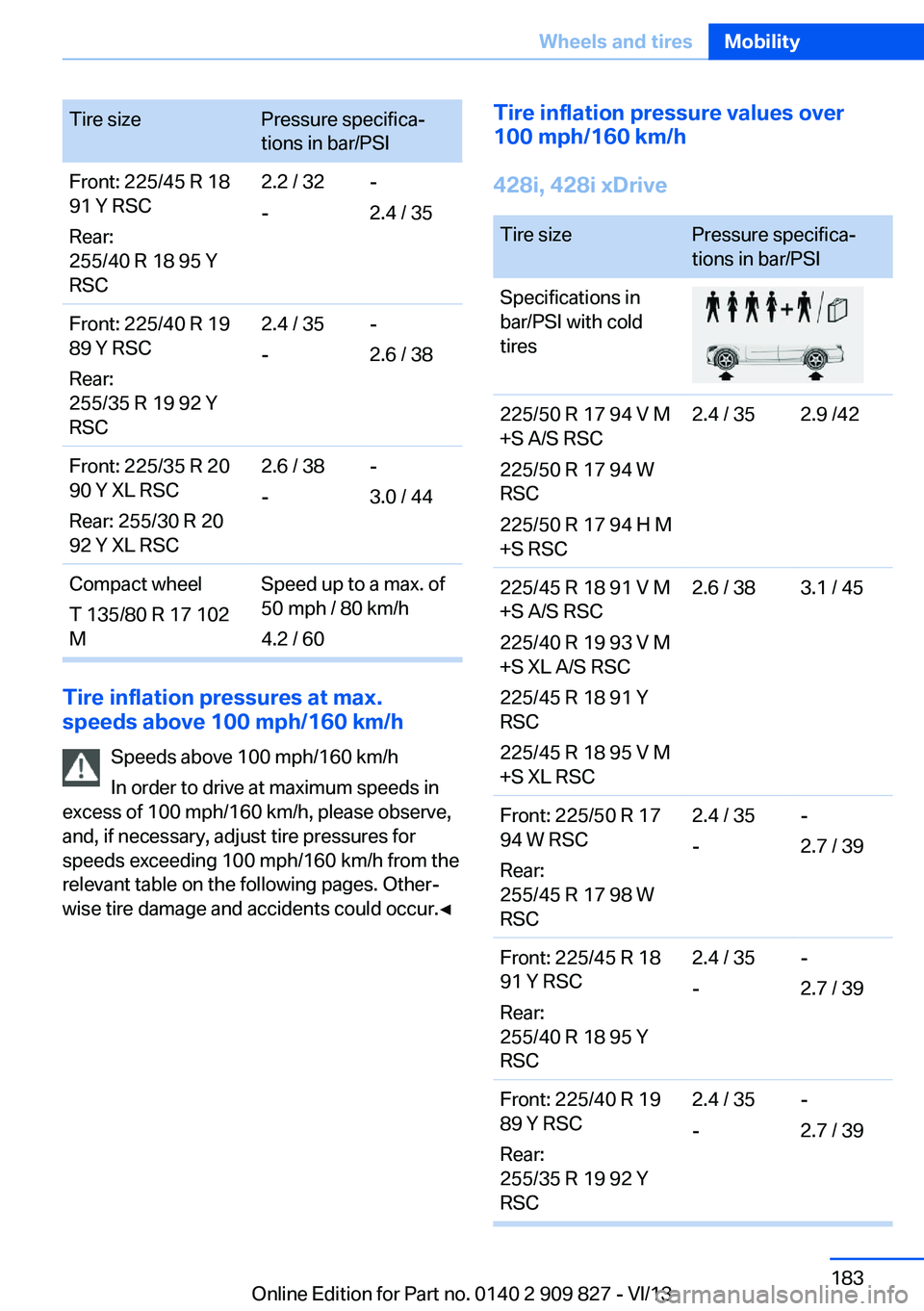
Tire sizePressure specifica‐
tions in bar/PSIFront: 225/45 R 18
91 Y RSC
Rear:
255/40 R 18 95 Y
RSC2.2 / 32
--
2.4 / 35Front: 225/40 R 19
89 Y RSC
Rear:
255/35 R 19 92 Y
RSC2.4 / 35
--
2.6 / 38Front: 225/35 R 20
90 Y XL RSC
Rear: 255/30 R 20
92 Y XL RSC2.6 / 38
--
3.0 / 44Compact wheel
T 135/80 R 17 102
MSpeed up to a max. of
50 mph / 80 km/h
4.2 / 60
Tire inflation pressures at max.
speeds above 100 mph/160 km/h
Speeds above 100 mph/160 km/h
In order to drive at maximum speeds in
excess of 100 mph/160 km/h, please observe,
and, if necessary, adjust tire pressures for
speeds exceeding 100 mph/160 km/h from the
relevant table on the following pages. Other‐
wise tire damage and accidents could occur.◀
Tire inflation pressure values over
100 mph/160 km/h
428i, 428i xDriveTire sizePressure specifica‐
tions in bar/PSISpecifications in
bar/PSI with cold
tires225/50 R 17 94 V M
+S A/S RSC
225/50 R 17 94 W
RSC
225/50 R 17 94 H M
+S RSC2.4 / 352.9 /42225/45 R 18 91 V M
+S A/S RSC
225/40 R 19 93 V M
+S XL A/S RSC
225/45 R 18 91 Y
RSC
225/45 R 18 95 V M
+S XL RSC2.6 / 383.1 / 45Front: 225/50 R 17
94 W RSC
Rear:
255/45 R 17 98 W
RSC2.4 / 35
--
2.7 / 39Front: 225/45 R 18
91 Y RSC
Rear:
255/40 R 18 95 Y
RSC2.4 / 35
--
2.7 / 39Front: 225/40 R 19
89 Y RSC
Rear:
255/35 R 19 92 Y
RSC2.4 / 35
--
2.7 / 39Seite 183Wheels and tiresMobility183
Online Edition for Part no. 0140 2 909 827 - VI/13
Page 184 of 236
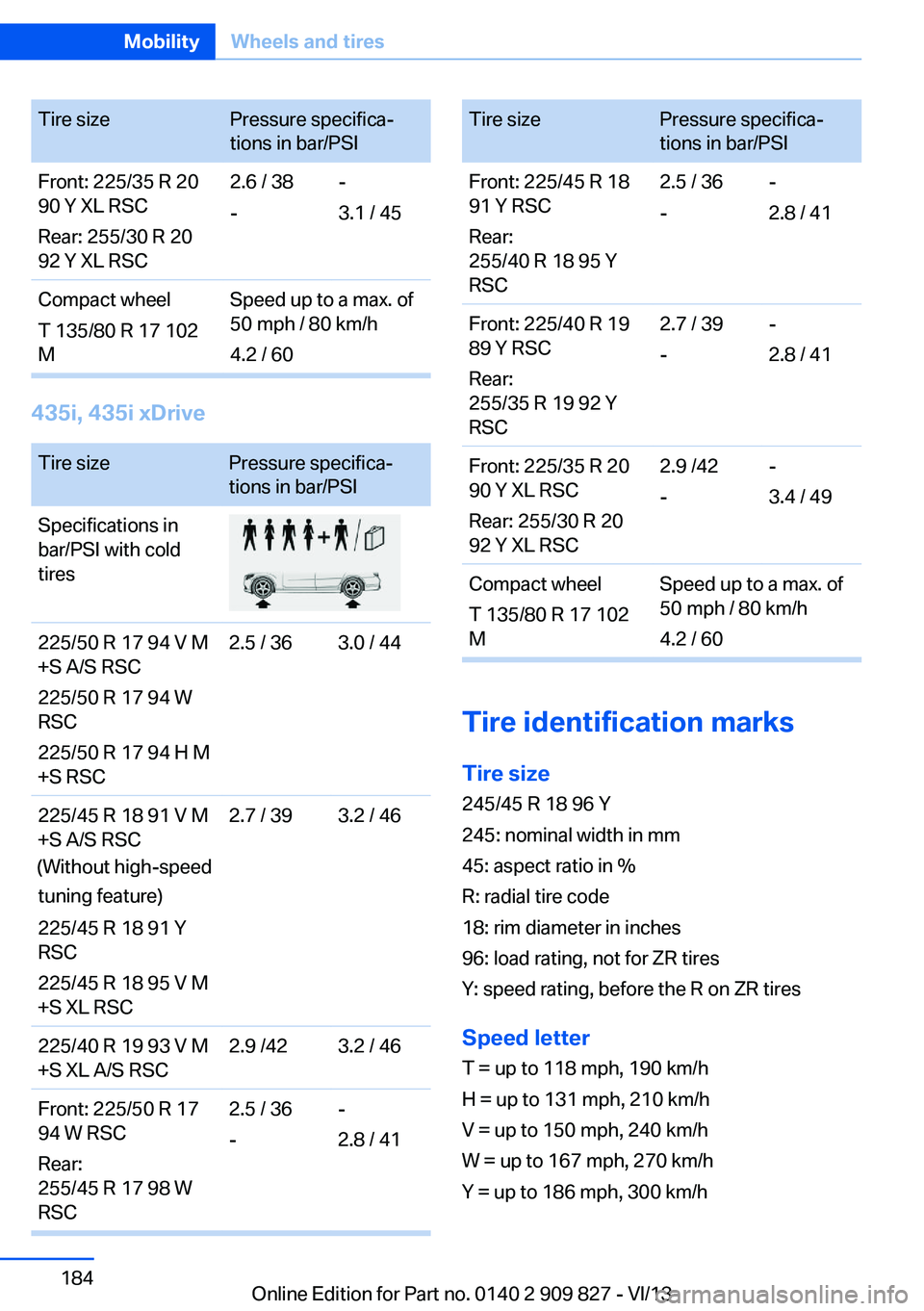
Tire sizePressure specifica‐
tions in bar/PSI
Front: 225/35 R 20
90 Y XL RSC
Rear: 255/30 R 20
92 Y XL RSC
2.6 / 38
-
-
3.1 / 45
Compact wheel
T 135/80 R 17 102
M
Speed up to a max. of
50 mph / 80 km/h
4.2 / 60
435i, 435i xDrive
Tire sizePressure specifica‐
tions in bar/PSI
Specifications in
bar/PSI with cold
tires
225/50 R 17 94 V M
+S A/S RSC
225/50 R 17 94 W
RSC
225/50 R 17 94 H M
+S RSC
2.5 / 363.0 / 44225/45 R 18 91 V M
+S A/S RSC
225/45 R 18 91 Y
RSC
225/45 R 18 95 V M
+S XL RSC
2.7 / 393.2 / 46225/40 R 19 93 V M
+S XL A/S RSC
2.9 /423.2 / 46Front: 225/50 R 17
94 W RSC
Rear:
255/45 R 17 98 W
RSC
2.5 / 36
-
-
2.8 / 41
Tire sizePressure specifica‐
tions in bar/PSI
Front: 225/45 R 18
91 Y RSC
Rear:
255/40 R 18 95 Y
RSC
2.5 / 36
-
-
2.8 / 41
Front: 225/40 R 19
89 Y RSC
Rear:
255/35 R 19 92 Y
RSC
2.7 / 39
-
-
2.8 / 41
Front: 225/35 R 20
90 Y XL RSC
Rear: 255/30 R 20
92 Y XL RSC
2.9 /42
-
-
3.4 / 49
Compact wheel
T 135/80 R 17 102
M
Speed up to a max. of
50 mph / 80 km/h
4.2 / 60
Tire identification marks
Tire size
245/45 R 18 96 Y
245: nominal width in mm
45: aspect ratio in %
R: radial tire code
18: rim diameter in inches
96: load rating, not for ZR tires
Y: speed rating, before the R on ZR tires
Speed letter
T = up to 118 mph, 190 km/h
H = up to 131 mph, 210 km/h
V = up to 150 mph, 240 km/h
W = up to 167 mph, 270 km/h
Y = up to 186 mph, 300 km/h
Seite 184MobilityWheels and tires184
Online Edition for Part no. 0140 2 909 827 - VI/13
(Without high-speed tuning feature)
Page 188 of 236
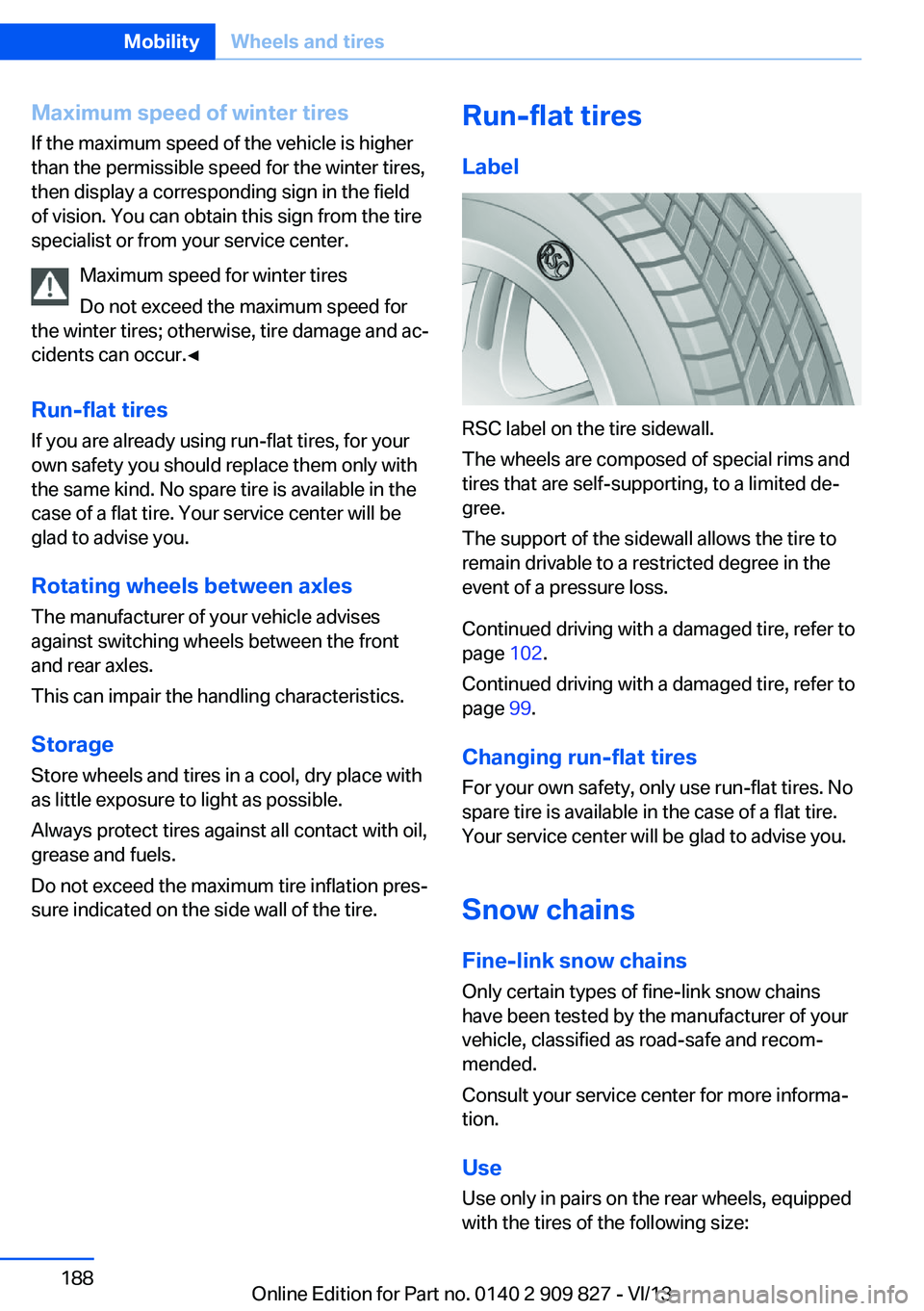
Maximum speed of winter tiresIf the maximum speed of the vehicle is higher
than the permissible speed for the winter tires,
then display a corresponding sign in the field
of vision. You can obtain this sign from the tire
specialist or from your service center.
Maximum speed for winter tires
Do not exceed the maximum speed for
the winter tires; otherwise, tire damage and ac‐
cidents can occur.◀
Run-flat tires If you are already using run-flat tires, for your
own safety you should replace them only with
the same kind. No spare tire is available in the
case of a flat tire. Your service center will be
glad to advise you.
Rotating wheels between axles The manufacturer of your vehicle advises
against switching wheels between the front
and rear axles.
This can impair the handling characteristics.
StorageStore wheels and tires in a cool, dry place with
as little exposure to light as possible.
Always protect tires against all contact with oil,
grease and fuels.
Do not exceed the maximum tire inflation pres‐
sure indicated on the side wall of the tire.Run-flat tires
Label
RSC label on the tire sidewall.
The wheels are composed of special rims and
tires that are self-supporting, to a limited de‐
gree.
The support of the sidewall allows the tire to
remain drivable to a restricted degree in the
event of a pressure loss.
Continued driving with a damaged tire, refer to
page 102.
Continued driving with a damaged tire, refer to
page 99.
Changing run-flat tires
For your own safety, only use run-flat tires. No
spare tire is available in the case of a flat tire.
Your service center will be glad to advise you.
Snow chains
Fine-link snow chains
Only certain types of fine-link snow chains
have been tested by the manufacturer of your
vehicle, classified as road-safe and recom‐
mended.
Consult your service center for more informa‐
tion.
Use
Use only in pairs on the rear wheels, equipped
with the tires of the following size:
Seite 188MobilityWheels and tires188
Online Edition for Part no. 0140 2 909 827 - VI/13
Page 189 of 236
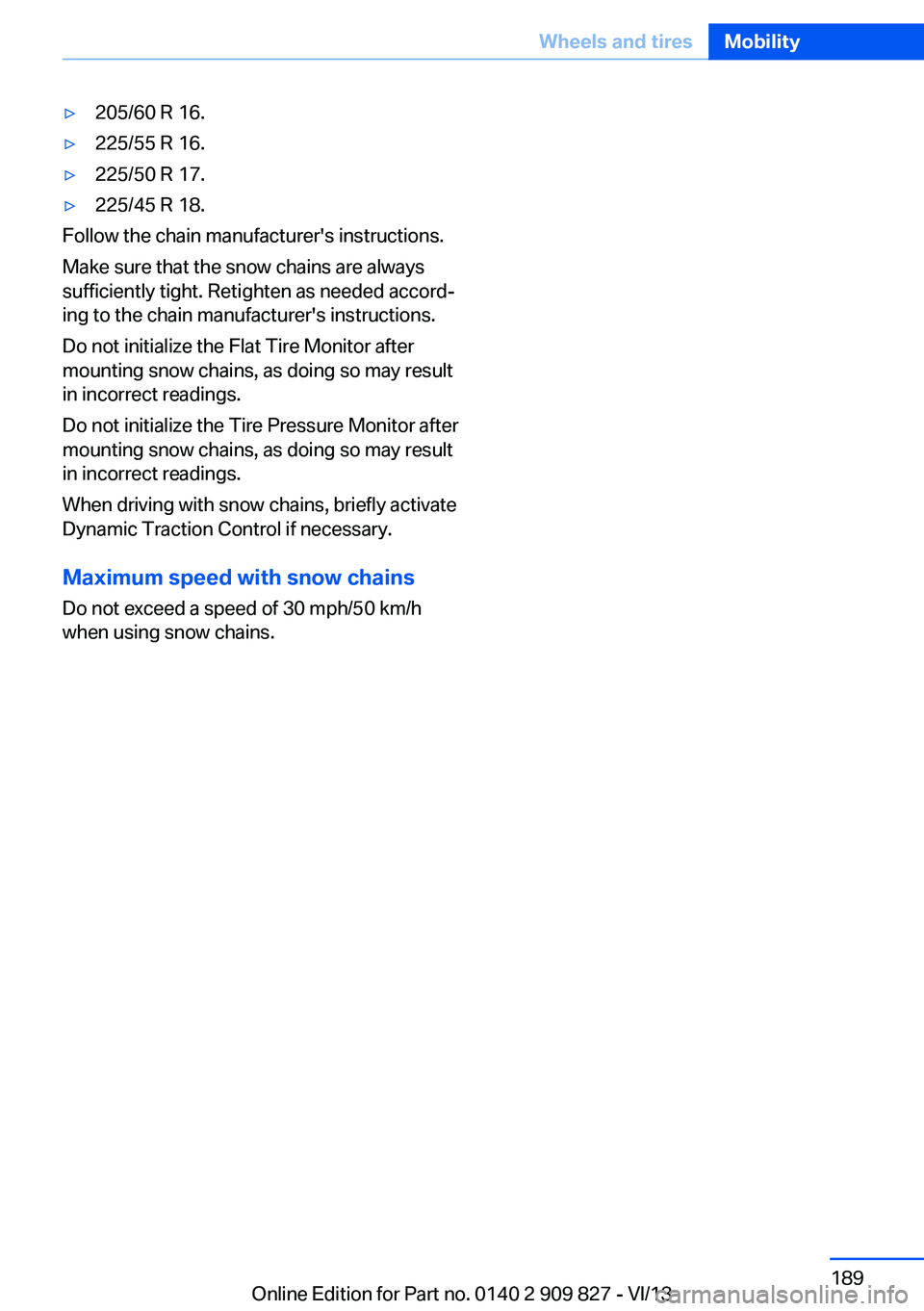
▷205/60 R 16.▷225/55 R 16.▷225/50 R 17.▷225/45 R 18.
Follow the chain manufacturer's instructions.
Make sure that the snow chains are always
sufficiently tight. Retighten as needed accord‐
ing to the chain manufacturer's instructions.
Do not initialize the Flat Tire Monitor after
mounting snow chains, as doing so may result
in incorrect readings.
Do not initialize the Tire Pressure Monitor after
mounting snow chains, as doing so may result
in incorrect readings.
When driving with snow chains, briefly activate
Dynamic Traction Control if necessary.
Maximum speed with snow chains Do not exceed a speed of 30 mph/50 km/h
when using snow chains.
Seite 189Wheels and tiresMobility189
Online Edition for Part no. 0140 2 909 827 - VI/13
Page 206 of 236
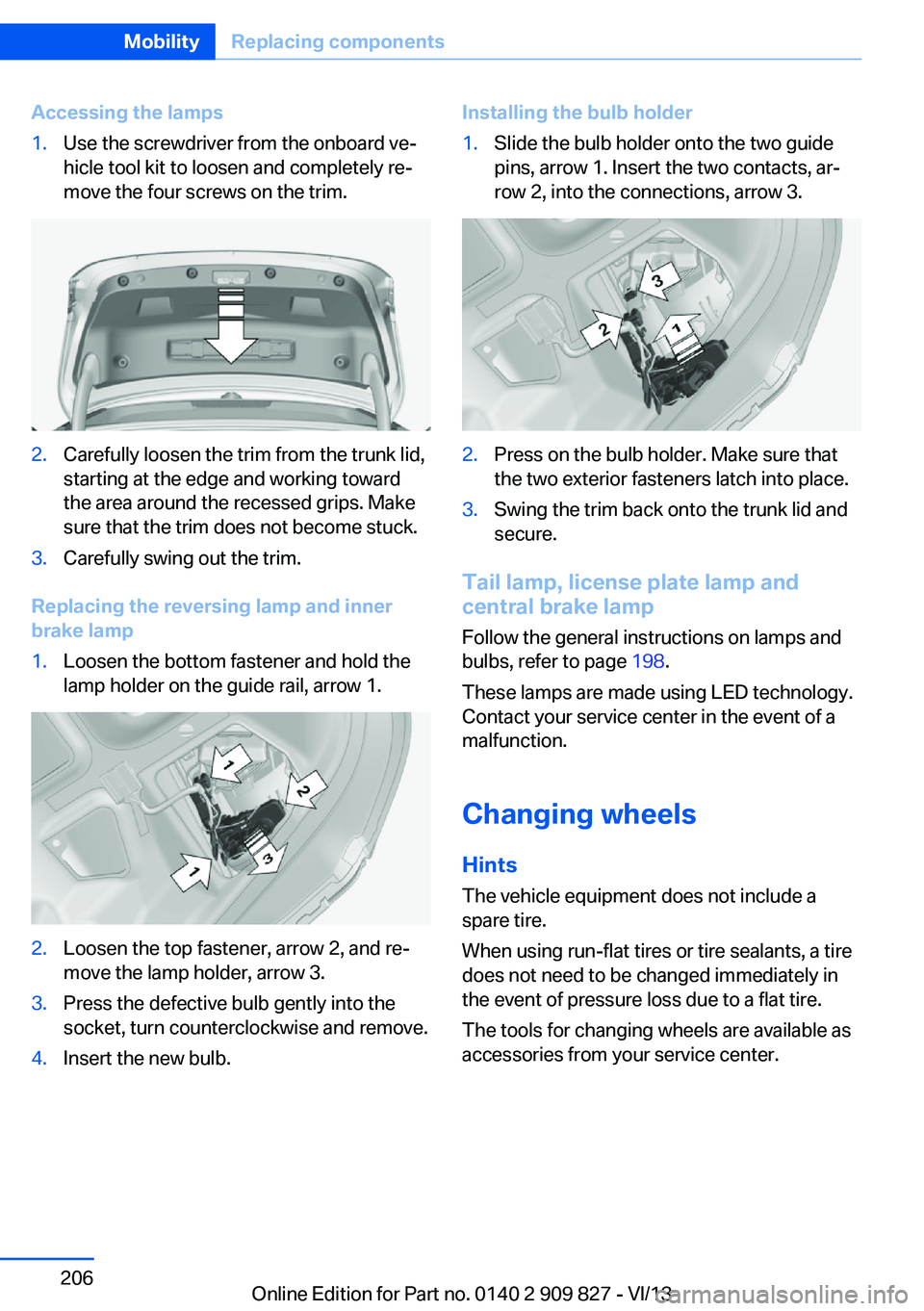
Accessing the lamps1.Use the screwdriver from the onboard ve‐
hicle tool kit to loosen and completely re‐
move the four screws on the trim.2.Carefully loosen the trim from the trunk lid,
starting at the edge and working toward
the area around the recessed grips. Make
sure that the trim does not become stuck.3.Carefully swing out the trim.
Replacing the reversing lamp and inner
brake lamp
1.Loosen the bottom fastener and hold the
lamp holder on the guide rail, arrow 1.2.Loosen the top fastener, arrow 2, and re‐
move the lamp holder, arrow 3.3.Press the defective bulb gently into the
socket, turn counterclockwise and remove.4.Insert the new bulb.Installing the bulb holder1.Slide the bulb holder onto the two guide
pins, arrow 1. Insert the two contacts, ar‐
row 2, into the connections, arrow 3.2.Press on the bulb holder. Make sure that
the two exterior fasteners latch into place.3.Swing the trim back onto the trunk lid and
secure.
Tail lamp, license plate lamp and
central brake lamp
Follow the general instructions on lamps and
bulbs, refer to page 198.
These lamps are made using LED technology.
Contact your service center in the event of a
malfunction.
Changing wheels
Hints The vehicle equipment does not include a
spare tire.
When using run-flat tires or tire sealants, a tire
does not need to be changed immediately in
the event of pressure loss due to a flat tire.
The tools for changing wheels are available as
accessories from your service center.
Seite 206MobilityReplacing components206
Online Edition for Part no. 0140 2 909 827 - VI/13